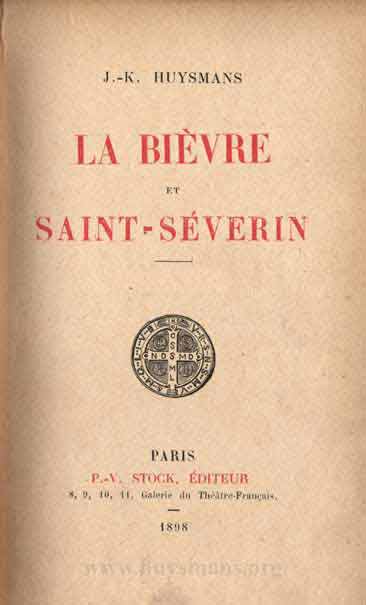The Spectator
14 January 1899.
Current Literature: New French Books
La Bièvre et Saint-Séverin. Par J. K. Huysmans. (Stock, Paris)
M. Huysmans has for the moment deserted the investigation of magic, black or white, and has turned again to the picturesque, in the search for which he won his earliest glory. La Bièvre et Saint-Séverin. will not be rewarded by the success of scandal, which attended "Là-Bas" and "La Cathédral." Yet none the less it is a remarkable work, simply conceived and exquisitely written. for M. Huysmans is master of a curious, elaborate style, and the practice of realism, which long since he despised, at least taught him to observe. In this his latest work, then, he has employed his double gift of vision and word-painting. He has chosen two forgotten quarters of Paris, and has described them with a gruesome sense of their poverty-stricken horror and their stately dilapidation, which never verges upon melodrama. Beneath the shadow of the Gobelins, watered by the once romantic Bièvre, there is a little corner which is unknown to Paris, and from which the inhabitants never emerge. There huddle the men and women who toil in tanneries and dye-works, and there the intrepid wayfarer may enjoy an unaccustomed experience. The river, now a mere ditch, is scrawled over with the slime of many colours. Strange houses, from whose windows gaze stranger faces, are perched at odd corners or flank the steep and tortuous alleys. Readers of "Les Misérables" may remember the Gavroche passed that way, but if M. Huysmans did not discover this unknown land, at least he has revived a swiftly fading memory. Of more varied interest, yet less remote, is the Quartier Saint-Séverin, haunted to-day, as it was haunted centuries ago, by the thieves and brigands of Paris. But it is not merely a quarter of ill-fame. It is glorified by those contrasts which make Paris the noblest of cities. As you thread this network of streets so strangely titled (it is impossible to better the names of the Rues Gît-le-Coeur and du Chat qui Pêche) you come upon the splendid Church of Saint-Séverin and the hapless ruin of St. Julien-le-Pauvre, the oldest church in Paris, now transformed out of all seeming by the decoration of Archimandrites. And there, on the edge of the vanished Place Maubert, "la Maub", as its frequenters used to call it, is the Rue Galande, famous for the Château Rouge, once the house of Gabrielee d’Estrée, now the club of the worst criminals of France. There is no grimier haunt in Europe, and few more interesting. Hither notorious burglars and assassins come night after night, well knowing that the proprietor is but a detective, knowing also that they, poor devils, have nowhere else to go. This tavern M. Huysmans has described in terms at once so moving and so just, that his pages produce a sensation of horror which the present writer, though he has seen the place, never felt before. But M. Huysmans’s book is not a mere piece of ornamental writing. It is a record as well. These half-known corners of Paris are doomed to perish at the approach of the unsheltered, convenient boulevard, and then M. Huysmans’s picturesque pages will earn the dignity of historic documents. Meanwhile, those who still haunt the Quartier Saint-Séverin, or wander by the bank of the melancholy Bièvre, now buried in a drain, will understand their truth and vividness.

